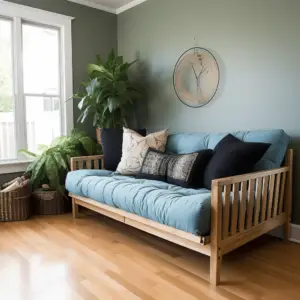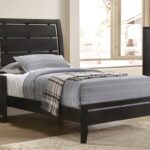Daybeds and Futons, have quite some similarities but also key differences. While they may serve similar purposes they are different most especially in terms of construction.
Depending on what you are looking for, either can be the choice for you but below are some attributes of the two that should help make your decision easier.
Table of Contents
Daybed Vs Futon: Overview

Futon
A futon also called a ‘Japanese mattress’ is a set composed of a simple mattress and a duvet. The mattress is the item of interest here and the Japanese mattress is a casing in which leftover textiles and cloths, silk waste, fibers, and straw are stuffed to form a pillow-like unit or futon, that is laid on a tatami or a straw mat and used as a bed.
This futon is light in weight and is usually folded and put in storage during the day to allow the room to be used some other way. They are often aired outside to prevent them from developing mold and dampness. Even today, futons are a prominent fixture in Japanese homes, especially in rural Japan.
Western-style futons borrow this same structure but are more compact. They are storebought and contain foam, sponge, or fiber of the same kind that you will find in a regular mattress. The western-style futon is a set composed of a fairy sturdy but thin mattress and a foldable metal or wood contraction that allows it to be retrieved and put away with ease.
Daybed
A daybed is a couch or a chaise lounge that doubles up as a bed. During the day a daybed is used for lounging and relaxing and at night it is used as a bed. The width dimensions vary but generally, the length of a daybed should be the standard bed size length of six feet.
A daybed has a backrest and armrests on either end just like a couch and is not foldable. You only need to retrieve bedding and spread it on a daybed to use it as a bed. In the daytime, strip the daybed of the bedding and it goes back to functioning as a couch.
Futon Vs Daybed
Comfort
A futon is smaller and generally less sturdy than a daybed. Futons have a much thinner mattress than a daybed as well. Although you can always go for a thicker mattress for your futon, the options are not as many as those of a daybed.
With a daybed, you can have a mattress of any thickness and type. It depends on what you want. Fact that it essentially has all the attributes of a bed including width and length that can accommodate the typical mattress, the daybed is the more comfortable choice between the two.
A daybed is also made with a more stable frame compared to the futon whose frame needs to be smaller for easier folding and moving about. While both are made with the intent to save space, the futon is considerably less robust and is best used occasionally or for a short while before acquiring a better bed.
Long-term use of a futon will cause back pain and muscle cramps while even the average daybed is a good solution for sleeping.
Versatility
Both futons and daybeds can double up as couches and beds but the daybed has even more range and can be modified to include storage or an extra bed.
The extra bed or trundle can be added onto the lower part of the daybed which will serve you well should you have guests sleeping over. If not, the underside can include drawers that will give you convenient and easy storage for bedding and clothes.
A futon does not offer these options so if you are going for what has more utility while still addressing your space concerns, go for the daybed.
Durability
Durability depends on both use and construction. The sturdier frame of the daybed makes it the more durable of the two. The fact that daybeds are not folded and unfolded or moved about means they are likely to remain in great condition longer.
Futons should give you a good five to ten years but since they are not made for permanence, they will have deteriorated in that time. For better durability, you may have to buy a more expensive futon but this does not give that much more durability. Both the frame and the mattress are significantly less wholesome compared to daybeds.
Aesthetic and Variety

A daybed is superior in both these aspects because of the sheer amount of options available for embellishing it. Most if not all the options available for a bed and a couch can be applied to a daybed making it one of the easiest pieces of furniture to work with.
The fact that Daybeds and Futons doesn’t need to be removed from its place means you only need to work with the bedding and any covers you deem fit for daytime use. The back and armrests in particular can be crafted in any way you see fit.
A futon comes with much fewer options but creativity should allow you to use available options to ensure it looks appealing to the eye even when it is in use as a couch. The options available are, however, not as varying as those of a daybed.
Assembly
Assembling a daybed and more so one with a trundle or storage drawers can be a tricky affair that could take quite some time. If possible, have an attendant accompany you to assemble it properly.
More than likely, you will miss a screw or a joining that will leave the bed unstable and cost you later when you inadvertently break it. The instructions tend to look easy to follow but assembling a daybed is not as straightforward.
A futon is easy to assemble and once done you only ever need to fold it down the middle if you need to remove it from its place. If you do not have to remove Daybeds and Futons, unfolding it to create the bed is the only maneuvering it requires.
Cost
A daybed generally costs more than a futon.


